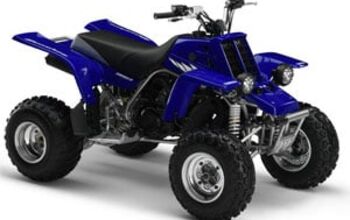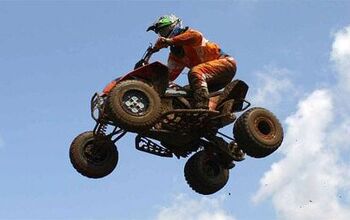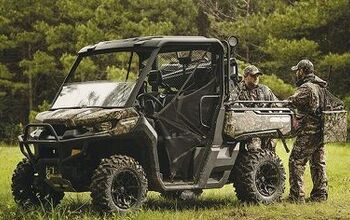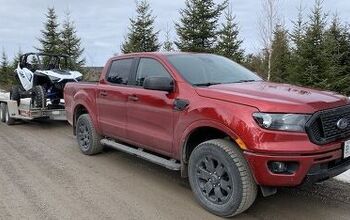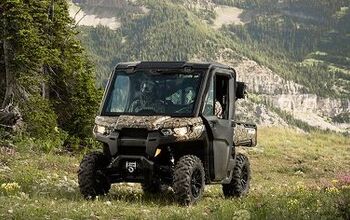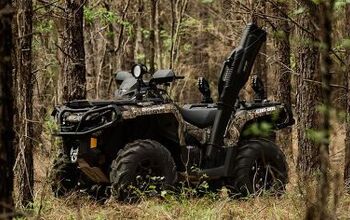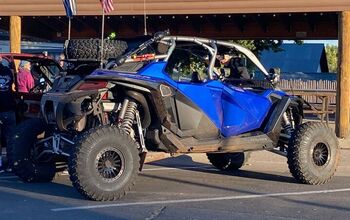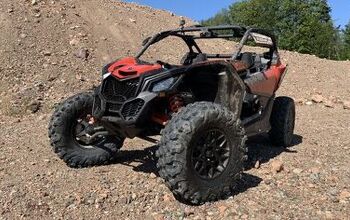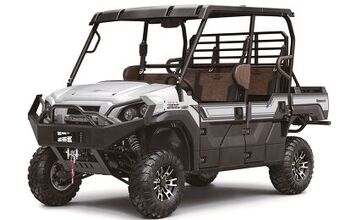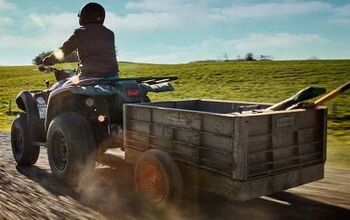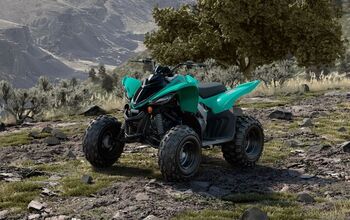2010 450cc Motocross Shootout – Part 2
In part one of our motocross shootout we compared the specifications, weights, horsepower, and price of the five high performance 450cc motocross quads – KTM 450 SX, Yamaha YFZ450R, Suzuki LT-R450, Can-Am DS 450 X mx, and Polaris Outlaw 450 MXR. We also gave each manufacturer a limited list of setup options in order to make their machine race legal and remove any performance restrictions normally addressed by the average racer. For part two we have once again assembled the five machines and five very different riders at one tremendous track capable of pushing even a fully built race machine to its limits. Our riders will compare on-track performance, lap times, provide our suspension settings and report on what holds up and what doesn’t.
It should be noted that both Honda and Kawasaki produce high performance 450cc sport quads, but neither are motocross width machines. With enough money spent they can be made into race winners, but since they aren’t close to motocross ready in stock trim they didn’t fit into our motocross shootout.
In order to prove the race ready potential of these machines for the average rider we knew we had to test at a track of national proportions. The tack we chose was Bar 2 Bar MX in Mt Sterling, Ky. This motocross monster features lots of altitude changes, a punishing uphill whoop section, tons of intermediate size jumps, and four huge leaps over 90 feet with the largest measuring in at an enormous 125 feet!
Our riders included 23-year-old former C and B national champion and current Pro-Am racer Aaron Meyer. At age 30 Chase Cunningham is capable of running the Pro-Am class. He was the 2008 +25 national champion and will most likely be racing A class at the GNC Nationals this year. At age 35 Dave Trimble has been racing for 20 years and has placed in the top five in the +30 class at the GNC Nationals. Also 35, Holly Trimble has been r acing for 10 years and has placed in top ten overall in the Women’s class at the GNC Nationals. Our youngest tester is 21-year-old Nacy Stone, the 2009 Open C class national champion. At his track Bar 2 Bar he is easily capable or running at a B class level and will most likely be running the open B class in the 2010 GNC National series.
To help us dial in each machine’s suspension and deal with any breakage issues we were given much appreciated assistance from GT Thunder Owner Lazarus Sommers and RC Motorsport’s Ron Kersey.
Motor
Close gear ratios hurt the Outlaw’s motor ranking.
As riders race down their first straight on a new machine generally the first thing they take note of is engine performance. Although on the dyno it had the third highest peak power at 48.11 horsepower and one of the strongest powerbands from the bottom through the midrange, the Polaris Outlaw MXR 450 came in fifth on the track. The two fastest riders gave the Polaris its highest praise. Meyer had the Outlaw in a tie for second, while Cunningham rated it third. The other riders all felt it ranked fifth. The Yoshimura exhaust did increase low to midrange power, but the intake needs to be addressed to take full advantage of even the stock exhaust. The Outlaw rates second in low end power, ties with Suzuki for fourth in midrange, and takes last on top end. Close gear ratios help magnify the machine’s narrower powerband which hurt the engine’s overall rideability rating and made it feel weaker then it actually is. With a hydraulic clutch it is unclear why our riders gave it last in clutch ease. We can only assume it’s because they were shifting a lot more often on the Polaris and wearing out their clutch hand. Going two teeth lower on the rear sprocket would spread the gears out a bit and go a long way in improving the engine’s rideability, but as it sits the MXR 450 engine lands in fifth.
Fourth place does not do the Can-Am’s motor justice.
Our testers felt the performance of the next three machines was separated by a very slim margin. While it wasn’t that impressive to look at on the dyno, when it came to power the Can-Am delivered on the track. Cunningham and Stone rated it second, Holly and Dave Trimble each rated it fourth, while Meyer rated it last, but all of the rider’s comments were pretty positive when it came to the DS’ motor. It’s a shame how bad the print magazines have rated this engine constantly shooting it out in stock trim where its bottom end power is almost non existent. The uncorked Motoworks Equipped DS 450 X mx rated third in low end power, but took second in both midrange and top end power. Shifting smoothness and clutch ease rated a bit lower which also held the engine’s rideability back, but overall the Can-Am’s motor was way better then you would expect for fourth place.
As one of only two machines to crack 50hp on the Dyno the Suzuki wasn’t the arm ripping monster one might expect. Instead its power was super smooth with the broadest powerband in the shootout. Holly and Dave Trimble ranked it second, Stone rated it third, Meyer rated it fourth and Cunningham ranked it last. The LT-R450 tied for fourth in both bottom end and midrange and took third in top end. While it didn’t shine anywhere in the RPM range it consistently built power revving higher then any other machine in the shootout, which minimized the need to shift. Complemented by a second place tie in both shifting smoothness and clutch ease plus a third place in rideability, the LT-R450 missed taking second by a whisper.
Despite its modest dyno numbers, the YFZ450R was a beast on the track.
On the dyno the Yamaha ranked fourth in peak power with 47.48 horsepower. Its power curve, however, looked more impressive and that transferred over to the track. That being said, the YFZ450R’s engine setup wasn’t quite perfect. Meyer ranked the engine second , Holly and Dave Trimble both rated it third, while Stone and Cunningham ranked it fourth. Yamaha claims that the YFZ450R’s fuel injection can compensate for an aftermarket exhaust. However, the GYTR slip-on exhaust and the removal of the airbox lid made it run too lean off the bottom, which cost it some low end power and made the engine hesitate at times while operating under heavy load low in the RPMs. In low end power the Yamaha is tied with Suzuki for fourth. It moved to third in midrange power and took fourth in top end. It has the smoothest shifting and the second easiest clutch pull in the shootout which help it take second in rideability. The addition of a power commander would have undoubtedly improved the YFZ450R’s power ratings. Post shootout testing proved that a power commander significantly boosts power and eliminates any feeling of hesitation in the lower RPMs. The additional cost wouldn’t have effected the placement of the YFZ450R’s as tested price either. Even with one hand tied behind the YFZ450R’s back its engine still takes second.
On the dyno the KTM put out over 51 horsepower and had the most impressive power curve from the bottom end through its peak. That same power curve transferred directly to the track as the 450 SX was rated highest by all of the riders in the shootout. The 450 SX takes top honors in each engine category except shifting smoothness where it takes second. Bone stock it puts out more power then most racers will ever need, giving the KTM top honors when it comes to engine performance.
Suspension
The LTR is a little too stiff for most riders.
All the power in the world means nothing if you can’t get it to the ground. With Fox Podium X shocks the Polaris has the most recognizable brand of suspension in the shootout; however, all of the riders felt that the 450 MXR’s shocks needed some refinement. Stone ranked the suspension the highest among the riders, giving it fourth. By itself the Polaris’ suspension doesn’t perform badly but compared to the other machines in the shootout it feels the harshest on every obstacle on the track so the Outlaw’s suspension takes fifth.
Suzuki updated the LTR’s suspension in 2008 looking to soften it up a bit. Holly Trimble gave the Suzuki second in suspension while Stone ranked it last. The other riders all ranked it fourth. The LT-R450 takes fourth in all of the suspension categories except for jump landings and tune-ability where it takes third. Suzuki definitely designed the LTR’s suspension for the track but they went a bit too far toward the stiff side, hurting its performance on small bumps. While the LT-R450’s suspension takes fourth it is definitely still race-able for the average rider.
All but the most aggressive riders will find the KTM settings a little harsh.
KTM set the 450 SX suspension up for heavier more aggressive riders, which is good, if you’re a heavier or a more aggressive rider. Holly Trimble tied the KTM for third while Dave Trimble gave it fourth. Stone and Meyer both gave the 450SX second and Cunningham had it tied for second. The SX takes third in acceleration bumps and ties for second in braking bumps. It takes third in the whoops and fourth on jump landings. Lazarus softened the KTM’s suspension up significantly but couldn’t make the ride plush enough for lighter or less aggressive riders. Although it took second in tune-ability, it was well back of the Yamaha, which who took first in the category giving the KTM third place overall in suspension.
Creeping past the KTM is the Can-Am. All of the test riders agreed that the Can-Am is the king of plushness. Stone ranked the DS 450 X mx suspension first, Holly Trimble and Cunningham tied it for second, Dave Trimble ranked it third, while Meyer gave it fourth. The DS takes top honors in acceleration and braking bumps and second place through the whoops and on jump landings. The rear shocks rebound damping was turned nearly all the way in, in an effort to control its fast rebound so it takes fourth when it comes to tuneability. Additionally it was difficult to get the machine’s rear ride height down. Its tall ride height hurts it in tight turns, but you could get away with running it on more wide open tracks. You can’t ask for much better bump absorbing quality from stock shocks so DS 450 X mx takes a strong second in suspension performance.
The YFZ suspension fits the widest range of riders.
Taking top honors is the Yamaha. The YFZ450R obviously impressed our riders as it was unanimously rated number one by everyone except Stone, who rated it fourth. The YFZ450R took top honors in whoops and jump landings. It took second in acceleration bumps and tied for second with the KTM in braking bumps. However, it was tuneability that proved to be its strongest point allowing the YFZ to be dialed in for all our riders’ varying weights and abilities. It has the most race-friendly shocks for the widest range of riders giving the YFZ450R top honors in suspension.
Suspension Settings (as recommended by GT Thunder)
| KTM 450 SX | |
| Front Shocks | Rear Shocks |
| Compression, backed all the way out | Compression, Two and a half turns out |
| Polaris Outlaw 450 MXR | |
| Front Shocks | Rear Shocks |
| Compression, two turns in | Compression, two turns out |
| Suzuki QuadRacer LT-R450 | |
| Front Shocks | Rear Shocks |
| Compression, two turns in | Compression, two turns out |
| Can-Am DS 450 X mx | |
| Front Shocks | Rear Shocks |
| Compression, one and a half turns out | Compression, two and a half turns in |
| Yamaha YFZ450R | |
| Front Shocks | Rear Shocks |
| Compression, full out | Compression, full out |
Handling
Suspension and handling go hand in hand, but there are many other factors that come into play in affecting a machine’s handling. Chassis geometry, dimensions, center of gravity, weight and weight bias all play a factor.
The Outlaw’s handling issues are the result of a narrower stance and taller ride height.
When it comes to the Polaris all of our riders ranked it near the bottom. Stone and Cunningham both gave it fifth while Holly Trimble tied it for fourth. Meyer and Dave Trimble both felt its handling beat out the Can-Am. The Outlaw’s disadvantage comes from its narrower stance and taller ride height. The MXR 450 scores fifth in all of the handling categories. If Polaris wants the 450 MXR to live up to its name when it comes to handling, the machine needs to be a bit wider and longer with a lower ride height. For now the consumer has to make these changes themselves which is why the Polaris takes fifth in handling.
Significantly better in fourth is the Can-Am. Stone gave the Can-Am top honors in handling, while Meyer and Dave Trimble ranked it fifth. Holly Trimble and Cunningham fell closer to the middle giving it second and third respectively. The DS 450 X mx ties for second when it comes to weight balance and weight feeling. It takes third in steering precision and fourth in both high speed and cornering stability. The rear shocks’ ride height couldn’t be lowered sufficiently, making the DS tippy in the turns compared to the other machines in the 50-inch width range. Additionally, the plush front shocks create some front end body-roll. Aftermarket suspension work could easily cure the ride height issues, but as is DS 450 X mx rides respectably in fourth.
The YFZ450R received no major complaints when it came to handling, but still managed to come in third. Dave Trimble rated the YFZ450R number one, Meyer ranked it third, Cunningham and Stone rated the YFZ fourth and Holly Trimble had it tied for fourth with Polaris. The Yamaha takes second in high speed stability and third in cornering stability. While Suzuki and KTM tie for top honors in weight feeling, Yamaha tied with Can-Am for third. The YFZ takes third in weight balance and fourth in steering precision although no one cited any steering issues. Not standing out in any one aspect of handling kept the Yamaha out of the top two spots. It’s hard to believe that a machine that handles this well still came in third.
Better riders will like the KTM’s agile handling.
Sneaking past the Yamaha into second place is the KTM. Cunningham gave the 450 SX top honors in handling. Stone and Meyer both ranked it second, while Dave and Holly Trimble scored it third. The 450 SX ties for first in weight feeling and ties for second in weight balance. It stands alone in second in both cornering stability and steering precision and takes third in high speed stability. Adding more caster to the KTM’s adjustable a arms would reduce some of its high speed twitchiness; however, this machine was designed to handle quickly. It’s a stable turner with razor sharp steering. The better rider the more they’ll like the KTM’s handling, but in a battle of averages it takes second.
As the oldest design in the shootout with the heaviest weight, Suzuki comes out of nowhere to steal the handling category. Meyer and Holly Trimble rated the LT-R450 as the best, Cunningham and Dave Trimble ranked it second, while Stone ranked it third. The LT-R450 stands alone taking top honors in every handling category with the exception of weight feeling where it tied for first with the lightest machine in the shootout, the KTM. The LT-R450 has an incredibly low center of gravity, its chassis has a good geometry and its width and length are right where they should be, making the LT-R450 the best handling machine on the track.
It may be the oldest design in the shootout, but LTR is tops in handling.
Brakes
Riders are so often concerned with power and handling that brakes are often given little consideration. Fortunately all of the brakes on these machines work so well that very little attention is necessary. In fact, Stone rated the brakes of all five machines the same.
KTM’s brakes are as good as anything we’ve tested.
Can-Am ended up if fifth place, despite first place votes from Stone and Holly Trimble. The main reason for Can-Am’s last place finish was the design of its brake levers. Polaris finished a notch above Can-Am in fourth, while Suzuki finished third and Yamaha second. KTM was the clear frontrunner in breaking. It was ranked first or tied for first by all our riders. The KTM’s brakes are arguably as good as anything available from the aftermarket.
Fit and Finish
Taller riders will be more comfortable on the DS.
The more comfortable a rider is on a machine the faster he or she will be willing to ride. While this is often overlooked by recreational riders, racers of all levels understand the importance of being comfortable on your ATV. When it came to fit and finish, the Polaris was rated fifth by all of the riders in the shootout for various reasons. The Polaris took last in ergonomics, control operation and lack of vibration. We learned in the past that a simple switch to a lower bend high quality aluminum bar transforms this machine’s ergonomics.
For the Can-Am fit and finish reviews were more mixed. The DS seemed better suited to taller riders, although everyone agreed the seat seemed a bit too high. It finished third in control operation and fourth in ergonomics and lack of vibration.
Up next is the Suzuki, which takes second in control operation and ties for second with the KTM for lack of vibration. Uncomfortable steel handlebars and the short distance between the seat and footpegs dropped the LTR to fourth in ergonomics
Yamaha is the clear winner in fit and finish.
Barely surpassing the LTR is the KTM. The KTM stands alone in second for ergonomics and ties with Suzuki in second for lack of vibration. The smaller profile levers weren’t favored by all of the riders and perhaps issues with the seat foam affected its control operation rankings where it took fourth.
Taking a decisive victory in fit and finish is the Yamaha. Consumers expect a higher level of refinement from the Japanese manufacturers and the YFZ450R doesn’t disappoint. It took top honors from all but one of our testers. With a clean sweep, the YFZ450R ranked number one in ergonomics, control operation and lack of vibration. Yamaha clearly took what it learned from the original well refined YFZ450 and applied it to the new YFZ450R as it has the best fit and finish in the shootout.
Lap Times
For our lap time testing each rider had to complete a three-lap moto on each ATV. Riders were given time off between motos to recover before jumping on the next machine and the ATVs were ridden randomly. We averaged all of the riders’ times together on the different machines to come up with an average moto time for each ATV.
Taking fifth in average moto times is the Polaris with a time of 7:01:95. All of the riders turned their slowest times on the 450MXR. Its narrower width, overly stiff suspension and narrower powerband with close gear ratios made it more demanding to ride.
The Outlaw is the least expensive ATV in this shootout. You’ll have to use some of the money you save on aftermarket products to catch up the rest of this field.
With an average moto time of 6:42:99 the Can-Am comes in fourth. Several of our test riders thought they turned their fastest moto times on this machine due to its strong motor and ultra plush suspension. Its tall rear ride height hampered its cornering stability, which was detrimental to its moto times. Dave Trimble went his second fastest and Holly Trimble went her third fastest on the DS 450 X mx, while the rest of the riders all turned in their fourth fastest motos.
Despite its strengths, our riders didn’t churn out their best times on the DS 450 X mx.
What may come as a huge shocker to some, the KTM had the third fastest average moto time at 6:35:45. Everything on the KTM happens fast. With the most powerful motor and brakes in the shootout combined with razor sharp handling and slightly too stiff suspension the KTM requires a highly skilled rider to take full advantage of its performance, especially when fatigued. Meyer, Stone, and Cunningham turned their first, second and third fastest moto times respectively on the 450 SX – it was Cunningham’s finial moto of the day. Holly and Dave Trimble each turned in their fourth fastest time on the KTM, which held its average time back a bit. This tells us that while the KTM might be the fastest machine in the shootout for extremely fast and aggressive racers, it may not be the fastest motocross quad for those who are less aggressive, especially late in the moto.
The KTM has a lot going for it, but it was just too much machine for some of our testers.
Taking second was the Yamaha with an average moto time of 6:23:54. The YFZ450R is simply the most comfortable, most refined feeling machine in the shootout. Its suspension worked everywhere on the track eating up both small and large hits with equal precision. All of the riders liked the Yamaha’s shocks regardless of weight or skill level. The engine’s midrange to top end power was good, but running lean down low in the RPMs made it more difficult to ride. Lightly modified this is a strong and smooth motor, it just doesn’t run as smoothly or pull quite as hard down low without a GYTR power commander to complement the slip-on exhaust. At the beginning of the day Holly Trimble didn’t care for the YFZ, but by the time the machine was dialed in she turned her fastest moto on it during her last moto of the day. Cunningham went fastest on the YFZ450R, while Meyer went his second fastest, Stone and Dave Trimble each put in their third fastest times.
A power commander might have been all that kept the YFZ450R from the quickest lap times.
We honestly never expected the oldest design in the shootout would have the fastest lap times but with an average moto time of 6:18:53 the LT-R450 takes first. While its overall power output is average, having the widest powerband in the shootout with an impressive peak horsepower number made the Suzuki’s engine one of the easiest to ride. As the best handling machine it was easier to take advantage of all the available power the LTR had to give, in spite of its dated feeling suspension. Stone and Dave Trimble turned their fastest motos on the LTR. Cunningham and Holly Trimble each turned their second fastest times and Meyer was his third fastest aboard the Suzuki.
Thanks to a wide powerband and superb handling, the LTR posted the best moto times in our shootout.
Breakage
With a long day of testing on such a demanding track we believed it was only a matter of time until something broke. Unbelievably the only things that did brake were the KTM’s handlebar mounted dash panel when Stone landed on it chest first and the Polaris developed several small cracks in the rear fenders right next to the seat. In the course of one day each of these machines was put through the equivalent of several National motocross races with virtually no maintenance, proving that even the least durable among them are impressively tough.
Conclusions
At this point some people will find themselves disappointed because in our shootout there is no single winner. All of these machines are winners, depending on how fast you are, how much money you have to spend and how much you stand to win in contingency. As tested, all of these machines are capable of winning at the local level and some of them could even compete in many of the classes at the national level. Dealers and manufacturers are making incredible deals to move units so now is the best time to buy in years. All that’s left is to go purchase the machine that fits you best and we will se you at the track in 2010.
Overall Ratings
| KTM | Yamaha | Can-Am | Suzuki | Polaris | Tester | |
| Engine | 8.5 | 7.83 | 7.33 | 8.0 | 7.0 | H. Trimble |
| 8.0 | 7.33 | 7.0 | 7.5 | 6.0 | D. Trimble | |
| 9.0 | 8.33 | 6.5 | 7.16 | 8.3 | A. Meyer | |
| 8.66 | 6.33 | 8.0 | 7.16 | 6.0 | N. Stone | |
| 9.3 | 8.33 | 8.83 | 8.16 | 8.5 | C. Cunningham | |
| 8.69 | 7.63 | 7.53 | 7.59 | 7.16 | Total | |
| Suspension | 6.2 | 7.4 | 6.2 | 7.0 | 5.2 | H. Trimble |
| 6.2 | 7.0 | 6.6 | 6.4 | 5.0 | D. Trimble | |
| 6.6 | 8.2 | 6.4 | 4.4 | 4.0 | A. Meyer | |
| 7.4 | 6.6 | 7.8 | 6.0 | 6.8 | N. Stone | |
| 8.6 | 9.0 | 8.6 | 8.2 | 7.0 | C. Cunningham | |
| 7.0 | 7.64 | 7.12 | 6.4 | 5.6 | Total | |
| Handling | 6.0 | 5.4 | 6.6 | 7.4 | 5.4 | H. Trimble |
| 6.6 | 7.6 | 3.8 | 7.4 | 5.0 | D. Trimble | |
| 7.8 | 7.6 | 6.2 | 8.0 | 6.4 | A. Meyer | |
| 6.4 | 6.0 | 7.0 | 6.2 | 4.8 | N. Stone | |
| 9.2 | 8.4 | 8.6 | 8.8 | 7.8 | C. Cunningham | |
| 7.2 | 7.0 | 6.44 | 7.56 | 5.88 | Total | |
| Brakes | 8.0 | 8.0 | 8.0 | 8.0 | 7.0 | H. Trimble |
| 8.0 | 8.0 | 4.5 | 7.0 | 6.0 | D. Trimble | |
| 8.0 | 8.0 | 7.0 | 8.0 | 8.0 | A. Meyer | |
| 8.0 | 8.0 | 8.0 | 8.0 | 8.0 | N. Stone | |
| 10.0 | 9.0 | 9.5 | 9.5 | 9.0 | C. Cunningham | |
| 8.4 | 8.2 | 7.4 | 8.1 | 7.6 | Total | |
| Fit and Finish | 7.0 | 7.33 | 7.0 | 8.0 | 6.3 | H. Trimble |
| 6.33 | 7.66 | 5.66 | 6.0 | 4.3 | D. Trimble | |
| 7.33 | 9.33 | 6.66 | 6.3 | 5.66 | A. Meyer | |
| 7.0 | 7.0 | 7.0 | 7.0 | 4.0 | N. Stone | |
| 8.33 | 9.0 | 8.66 | 8.33 | 7.3 | C. Cunningham | |
| 7.19 | 8.06 | 6.99 | 7.13 | 5.51 | Total |
Related Reading
More by Joe Tolle





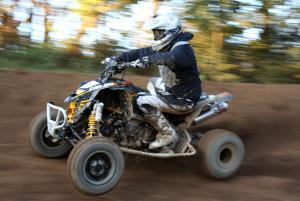
























![2012 Yamaha YFZ450 Review [Video]](https://cdn-fastly.atv.com/media/2022/10/24/8761983/2012-yamaha-yfz450-review-video.jpg?size=350x220)
